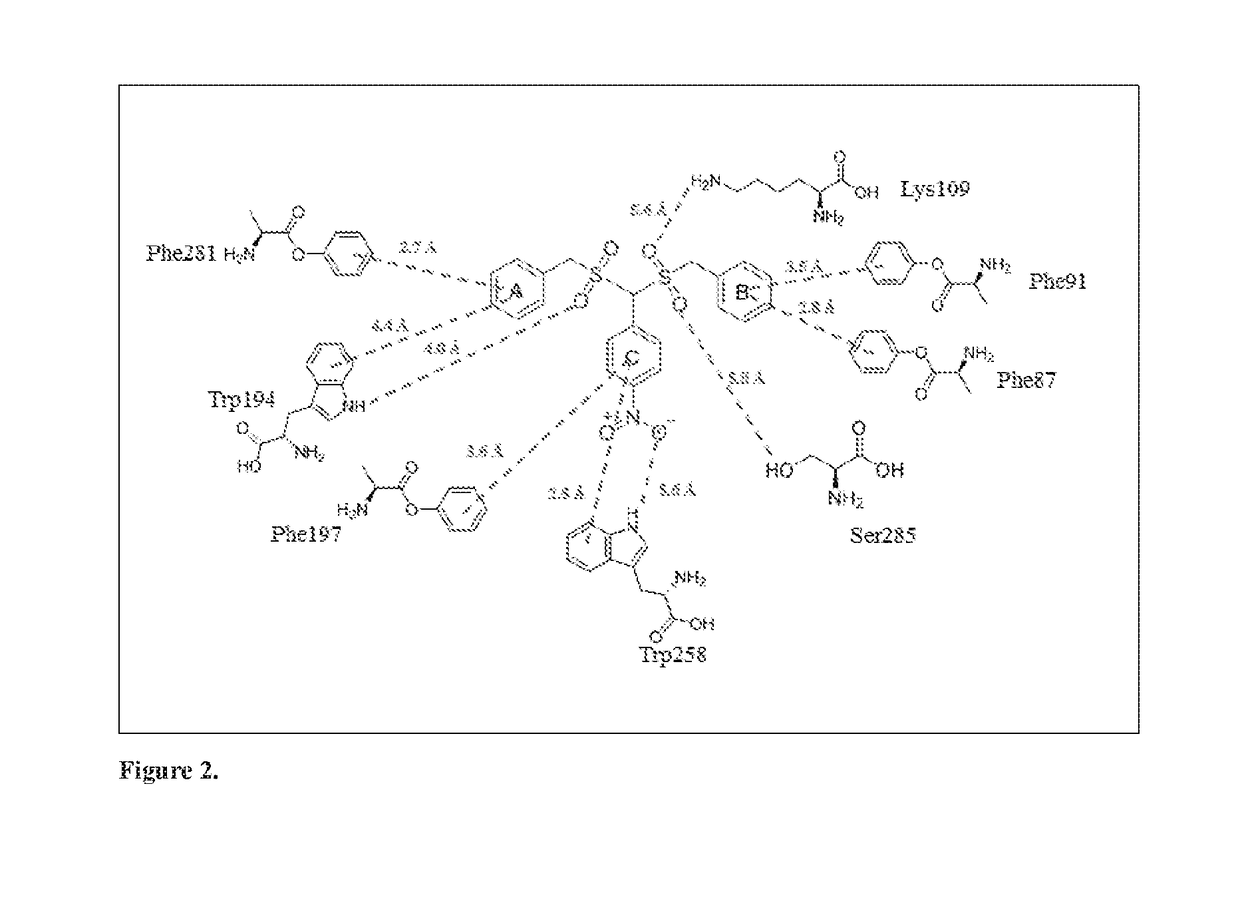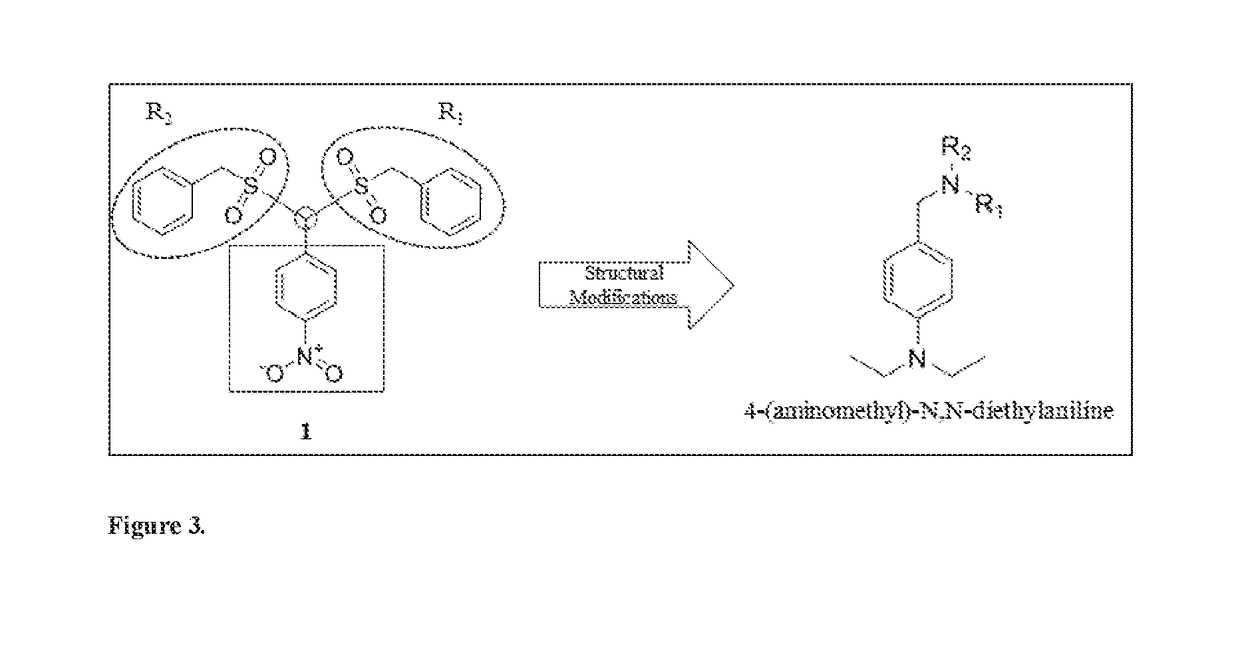Novel cannabinoid receptor cb2 ligand 4-(aminomethyl)-n,n-dialkylanilines
a cannabinoid receptor and cb2 technology, applied in the field of cannabinoid research, can solve the problems of mm patients not responding to cannabinoid (cb) drug research, medical marijuana or cannabinoid (cb) has reached certain limitations, and about 30% of patients with mm never respond to drug treatmen
- Summary
- Abstract
- Description
- Claims
- Application Information
AI Technical Summary
Benefits of technology
Problems solved by technology
Method used
Image
Examples
example 1
[0097](E)-N,N-diethyl-4-(((3,4,5-trimethoxybenzyl)imino)methyl)aniline (2). (3,4,5-trimethoxyphenyl)methanamine (1972 mg, 10 mmol) was added slowly to a solution of 4-(diethylamino)benzaldehyde (1770 mg, 10 mmol) and methanol (20 mL). The mixture was stirred and refluxed for 12 hours. The reaction mixture was cooled to room temperature, and the solvent was removed by evaporation under vacuum to give the crude compound 2, which was used in the next step without further purification.
example 2
[0098]N,N-diethyl-4-(((3,4,5-trimethoxybenzyl)amino)methyl)aniline (3). The crude compound (E)-N,N-diethyl-4-(((3,4,5-trimethoxybenzyl)imino)methyl)aniline (2) was dissolved in methanol (20 mL), and NaBH4 (570 mg, 15 mmol) was added. Stirring of the mixture was continued for 12 hours at room temperature. The reaction solution was poured into water and extracted with ethyl acetate (EA). The combined organic layers were washed with water and brine and then dried over Na2SO4. The residue was purified by flash chromatography (ethyl acetate / petroleum ether, 1:2) on silica gel to obtain the final product (3) as yellow oil (3350 mg, yield: 93%). 1H NMR (400 MHz, DMSO-d6) δ 7.12 (d, J=8.4 Hz, 2H), 6.65 (s, 2H), 6.62 (d, J=8.8 Hz, 2H), 3.76 (s, 6H), 3.64 (s, 3H), 3.60 (s, 2H), 3.54 (s, 2H), 1.07 (t, J=12 Hz, 6H). LC-MS (ESI): m / z 359.0 (M+H)+.
example 3
[0099]N-(4-(diethylamino)benzyl)-4-methoxy-N-(3,4,5-trimethoxybenzyl)benzenesulfonamide (4). The intermediate N,N-diethyl-4-(((3,4,5-trimethoxybenzyl)amino)methyl)aniline (compound 3) (358 mg, 1.0 mmol) in dichloromethane (DCM, 10 mL) was chilled in an ice bath with the exclusion of moisture, and then triethylamine (TEA, 121 mg, 1.2 mmol) was added to it. The resulting solution was treated drop-wise under stirring with 4-methoxybenzenesulfonyl chloride (206 mg, 1.0 mmol) in DCM over 30 minutes at 0° C. and then left overnight at room temperature. The reaction solution was poured into water and extracted with EA. The combined organic layers were washed with water and brine and then dried over Na2SO4. The mixture was filtered and the solvent was evaporated under vacuum. The residue was purified by flash chromatography (ethyl acetate / petroleum ether, 1:2) on silica gel to obtain N-(4-(diethylamino)benzyl)-4-methoxy-N-(3,4,5-trimethoxybenzyl) benzenesulfonamide (4). Yellow solid (432 mg...
PUM
| Property | Measurement | Unit |
|---|---|---|
| density | aaaaa | aaaaa |
| density | aaaaa | aaaaa |
| time | aaaaa | aaaaa |
Abstract
Description
Claims
Application Information
 Login to View More
Login to View More - R&D
- Intellectual Property
- Life Sciences
- Materials
- Tech Scout
- Unparalleled Data Quality
- Higher Quality Content
- 60% Fewer Hallucinations
Browse by: Latest US Patents, China's latest patents, Technical Efficacy Thesaurus, Application Domain, Technology Topic, Popular Technical Reports.
© 2025 PatSnap. All rights reserved.Legal|Privacy policy|Modern Slavery Act Transparency Statement|Sitemap|About US| Contact US: help@patsnap.com



